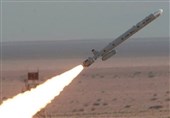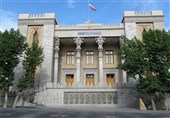Israeli Forces' Role in Be'eri Kibbutz Slaughter Unearthed
TEHRAN (Tasnim) – During the Al-Aqsa Storm operation on October 7, Israeli security forces killed over one hundred settlers, 25 of whom were Be'eri Kibbutz inhabitants, when they encountered unexpected challenges that resulted in over 1,100 casualties.
In a recent speech addressing the Al-Aqsa Storm operation, Seyyed Hassan Nasrallah, the secretary general of Hezbollah in Lebanon, unveiled a perspective that was previously overlooked by the media. Nasrallah directly spoke to the residents of the occupied territories, highlighting the fact that a number of Zionists were killed by their own regime's security and military forces.
Israeli forces killed Israeli residents in the occupied territories, both accidentally due to a lack of preparedness and errors by the forces, and intentionally to prevent their capture by the resistance forces.
A noteworthy statistic emerges as Tasnim examines the data on conflicts and fatalities in the early days of this operation. Of the approximately 1,100 casualties, between 80 and 100 individuals were victims of the regime's security forces, with 25 of them happening in the Be'eri Kibbutz conflict.
In the initial moments of the operation, multiple kibbutzim and Zionist settlements around Gaza became embroiled in the conflict. Among them, Be'eri, Kafr Gaza, Kissufim, and Netiv HaAsara held particular significance.
This report delves into the events that transpired within Be'eri Kibbutz, a community with around 1,200 residents and one of the most densely populated kibbutzims in close proximity to Gaza, located less than 4 kilometers away. Be'eri was among the first locations to bear the brunt of the conflict on October 7.
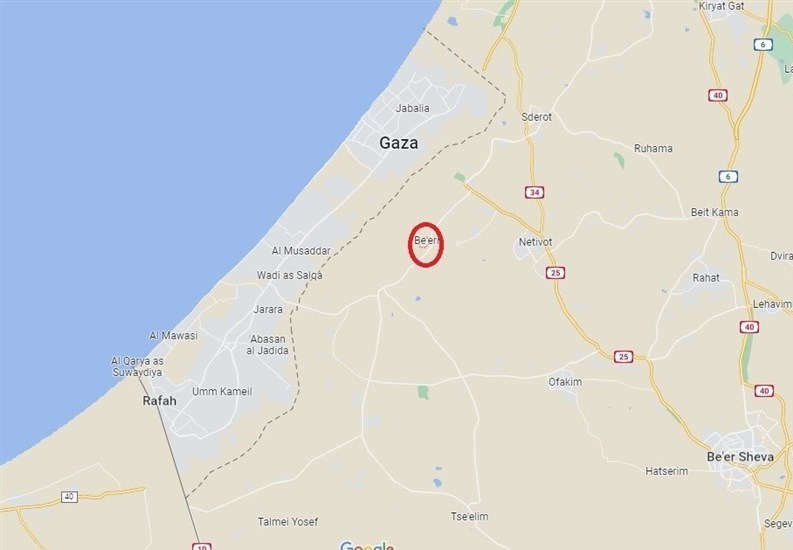
The geographical location of Kibbutz Be'eri in relation to the Gaza Strip.
According to Israeli sources, the Al-Aqsa Storm operation commenced at 6:30 in the morning. As recounted by a member associated with Be'eri Kibbutz's security team, the initial clash within the kibbutz occurred at precisely 6:59.
During this confrontation, Palestinian forces, consisting of roughly 170 individuals (150 from the Al-Qassam Brigades and 20 from the Abu Ali Mustafa Brigades), continued the battle until the afternoon of October 9, spanning two days.

Entry points which the resistance forces used to enter Kibbutz Be'eri.
Strikingly, reports indicate that the initial alert regarding the Palestinian group's attack did not originate from military sources but rather came directly from the Kibbutz’s settlers. This revelation hints at the possibility of cyberattacks targeting the Israeli army's surveillance systems and communication equipment in the lead-up to the conflict.
Yakhlai Bankut, the commander of the Be'eri Kibbutz protection team, described the situation, saying, "About 20 minutes after the attack began, one of the farm members contacted me and reported seeing Palestinians on motorcycles circling the kibbutz."
"I was sure it was a joke; the army had given us no warning. Ten minutes later, I received hundreds of calls from kibbutz residents informing me that the Palestinians were at their house entrances," he added.
The initial engagement resulted in casualties among the kibbutz defenders, including 11 members of the protection unit. Additionally, certain military units in the area, such as Golani Brigade 13, and specific police forces that responded to the conflict, faced losses and were forced to withdraw.
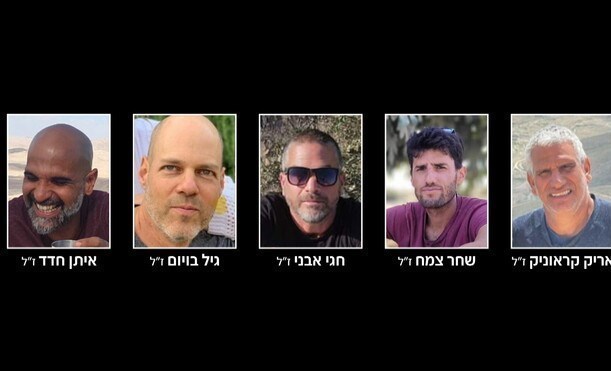
Photographs depicting killed members of Kibbutz Be'eri's security unit.
Following operational guidelines, auxiliary forces were expected to be dispatched to the area 10 minutes after the initial confrontation. However, due to the scattered nature of the conflicts in other areas, the first auxiliary unit, known as "Shaldag," consisting of 14 members, arrived at the scene around 9 a.m. – approximately 2 hours after Hamas forces had entered the kibbutz and taken positions at the kibbutz entrance.
Shaldag, a special unit within the Israei air force, ranks among the top units alongside "Sayeret Matkal" and "Shayetet 13." Alongside the Shaldag unit, other auxiliary forces from Shayetet 13 (special naval forces), Yahlom (Special Combat Engineering Unit), Luter Unit (special anti-terrorism unit of the army), Yamam (special police unit), one unit from Aman (Military Intelligence), and one unit from Shabas (Prison Services) were dispatched to Be'eri Kibbutz. Each of these units suffered casualties during the confrontation with resistance forces. Israeli sources reveal that in the Be'eri Kibbutz clash, 103 resistance force members lost their lives, while 85 Israelis were killed by the resistance forces. On the afternoon of October 9, the Israeli army's emergency services transported the bodies of 110 individuals.

Some of the deceased individuals from Kibbutz Be'eri are being transfered.
The deaths of 25 Be'eri Kibbutz residents at the hands of Israeli military forces can be attributed to two primary factors. First, the unpreparedness and lack of readiness of the forces to counter the unexpected threat imposed upon them. Second, the deliberate strategy of the Israeli army to target individuals who were at risk of falling into the hands of the resistance groups.
During the Be'eri Kibbutz confrontation, the resistance forces managed to transfer more than 30 captives with them to Gaza. The total number of captives in Hamas's custody has now reached 250. In light of these circumstances, Israeli security and military forces have opted to eliminate some captives considered to be at higher risk compared to others, aiming to prevent further captives. It is believed that one of Israel's primary objectives in its assault on Gaza is to either secure the release of the captives or, if not feasible, eliminate them to avert future consequences.
In a recent video released by Hamas, one of the female captives strongly protested against Netanyahu for the regime's decision to eliminate captives.
Furthermore, based on released images, certain concrete structures in Be'eri Kibbutz lay in ruins. The destruction appears to be a result of heavy Israeli firepower. While the resistance forces were equipped with individual weapons and RPGs, the extent of the damage to the kibbutzim's structures indicates that these demolitions resulted from weaponry weighing at least 70 kilograms.

The Israeli Channel 12, in part of its report on the events of the first day in Be'eri Kibbutz, disclosed that an Israeli air force fighter jet had targeted the kibbutz's kindergarten. However, they have refrained from disclosing casualty figures arising from this attack.
Reports suggest that the assault on the kindergarten of Be'eri Kibbutz was carried out at the request of General Barak Hiram, the commander of the operational forces in the region. Barak Hiram, who formerly held various military positions, including commanding the Aguz training unit and the Golan Brigade, is also considered a potential candidate for leading the Gaza Division in the south.
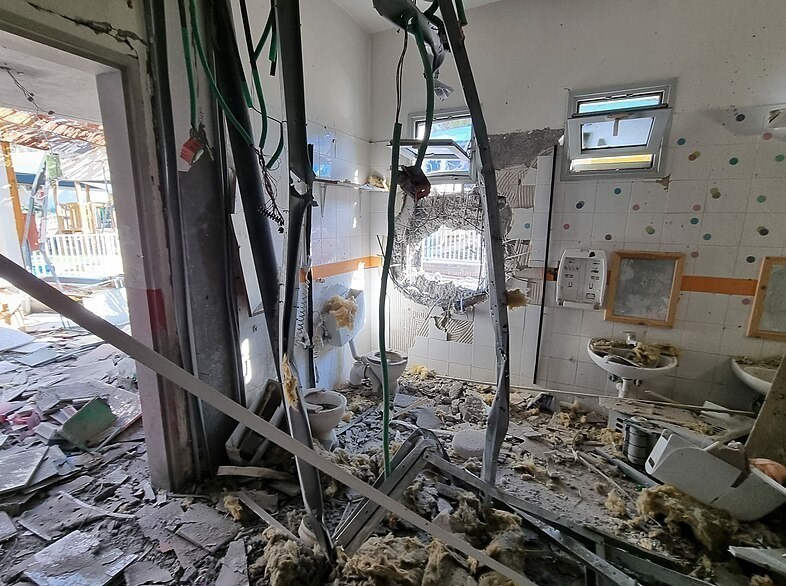
The condition of the kindergarten after the attack.
The performance of the Israeli military forces under the command of Barak Hiram during the October 7 conflict has sparked considerable criticism. One member of Be'eri Kibbutz's protection team expressed his dismay to Israel's Channel 12, stating, "When we were heavily engaged with the invaders, army auxiliary forces were waiting outside the area, merely observing the scene." He emphasized, "Their behavior was very disheartening, especially when I saw that only a small number of forces had arrived here."
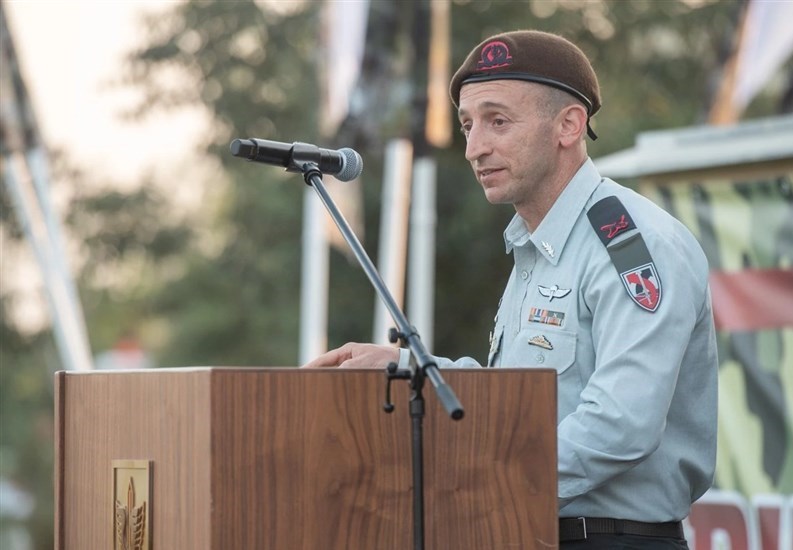
Barak Hiram, who previously held various military positions, including the Egoz training unit and the command of the Golan Brigade, is also considered a candidate for the command of the Gaza Division in the south.



